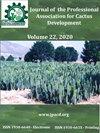Integrated Postharvest of Pitahaya fruits (Hylocereus ocamponis) stored at different temperaturs
IF 0.4
4区 农林科学
Q4 HORTICULTURE
Journal of the Professional Association for Cactus Development
Pub Date : 2023-05-22
DOI:10.56890/jpacd.v25i.521
引用次数: 0
Abstract
Pitahaya (Hylocereus spp.) has been placed successfully in the global fruit market due to its exotic appearance and pleasant flavor; however, its short postharvest life has limited its marketing in national and international markets. The postharvest life and final quality of fruits depend on the state of maturity in which the fruit is harvested, as well on the storage conditions. The aim of this study was to assess the postharvest behavior of pitahaya fruits (H. ocamponis) harvested during two states of maturity (pre-consumer and consumption maturity), stored at 6 ± 1°C and 22 ± 3 °C for 24 days. The color, firmness, epicarp thickness, weight loss, soluble solids, total soluble sugars, betalains, phenolic compounds and antioxidant activity showed significant changes during the storage period. The preserved fruits at room temperature maintained their firmness and color of the epicarp, content of soluble solids, soluble sugars and betalains during 9 days of storage, but from the 16th day, they showed rottenness and degradation of epicarp betalains. In contrast, the stored fruits in refrigeration presented a lower weight loss, greater firmness, and epicarp thickness, reaching 24 days of shelf life. The antioxidant activity was greater in the pulp of the stored fruits at 22 °C, due to an apparent higher betalains concentration associated with greater water loss in the fruit.不同温度贮藏火龙果的综合采后研究
火龙果(Hylocereus spp.)因其异国情调的外观和宜人的味道而成功地在全球水果市场上占有一席之地;然而,其采后寿命短,限制了其在国内和国际市场的销售。水果的采后寿命和最终质量取决于果实采收时的成熟状态,以及储存条件。本研究的目的是评估在6±1℃和22±3℃保存24天的两种成熟状态(消费前和消费期)下收获的火龙果(H. ocamponis)的采后行为。贮藏期间,果皮颜色、硬度、果皮厚度、失重、可溶性固形物、总可溶性糖、甜菜素、酚类化合物和抗氧化活性发生了显著变化。室温保存的果脯在9 d内保持了果皮的硬度和颜色、可溶性固形物、可溶性糖和甜菜碱的含量,但从第16 d开始,果皮甜菜碱开始腐烂和降解。相比之下,冷藏后的果实失重更小,硬度更大,外果皮厚度更厚,保质期可达24天。在22°C下储存的果肉中抗氧化活性更强,这是由于果实中β素浓度明显较高,水分损失也较大。
本文章由计算机程序翻译,如有差异,请以英文原文为准。
求助全文
约1分钟内获得全文
求助全文
来源期刊

Journal of the Professional Association for Cactus Development
Agricultural and Biological Sciences-Plant Science
CiteScore
1.10
自引率
33.30%
发文量
10
期刊介绍:
The editors of the Journal of the Professional Association for Cactus Development, are very excited to be a part of the excellent editorial committee and to work together to create the synergism between scientists, growers, legislators, and business people so vital to the development of this industry to serve the people of arid lands.
 求助内容:
求助内容: 应助结果提醒方式:
应助结果提醒方式:


